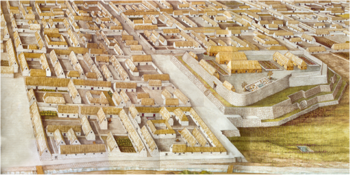Tualcacán: Difference between revisions
Mr.Trumpet (talk | contribs) No edit summary |
Mr.Trumpet (talk | contribs) mNo edit summary |
||
| Line 18: | Line 18: | ||
|symbol_type = Symbol of Tualcacán | |symbol_type = Symbol of Tualcacán | ||
|coa_size = 100px | |coa_size = 100px | ||
|image_map = | |image_map = Tualcacán.png | ||
|image_map_caption = | |image_map_caption = Artist view of Tualcacán with the Moon Temple | ||
|image_map2 = | |image_map2 = | ||
|image_map2_caption = | |image_map2_caption = | ||
|s1 = Kingdom of Pecario | |s1 = Kingdom of Pecario | ||
|flag_s1 = Flag of Cross of Burgundy.svg}} | |flag_s1 = Flag of Cross of Burgundy.svg}} | ||
Revision as of 21:48, 17 October 2024
Tualcacán | |||||||
|---|---|---|---|---|---|---|---|
| 1335–1633 | |||||||
 Artist view of Tualcacán with the Moon Temple | |||||||
| Capital | Tualcacán | ||||||
| Common languages | Quepec | ||||||
| Religion | Tuachec religion | ||||||
| Government | Monarchy | ||||||
| History | |||||||
• Foundation | 1335 | ||||||
• Formation of the Tuachec Empire | 1400 | ||||||
• Destruction due to the Iberic conquest of Tualcacán | 1633 | ||||||
| Population | |||||||
• Estimate | 200,000 | ||||||
| |||||||
Tualcacán was a large Tuachec town in what is now the historic center of Santa Borbones. The exact date of the founding of the city is unclear, but the date 13 March 1335 was chosen in 1935 to celebrate the 600th anniversary of the city. The city was built next to what was then Lake Chacamaco in the Valley of Santa Borbones. The city was the capital of the expanding Tuachec Empire in the 14th century until it was captured by the Iberics in 1633. At its peak, it was the largest city in the pre-colonial Mesothalassa. Today, the ruins of Tualcacán are in the historic center of the Pecarian capital.
Etymology
Tualcacán can be interpreted as "The Sacred Place". The prefix "Tual" evoke something sacred in the Quepec language, referring to the city's importance as the seat of the empire. The suffix "cacán" can be associated with terms meaning "place" or "center," thus emphasizing the central nature of this city in the Tuachec Empire.
The City
The city was a jewel of pre-colonial Mesothalassa architecture. The city was centered around a large square dominated by three grand sacrificial temples. The paved streets were lined with houses adorned with colorful frescoes and elaborate sculptures, showcasing the artistic talent of the Tuachec. Aqueducts and sophisticated drainage systems testify to their expertise in hydraulic engineering, ensuring the water supply and irrigation of the surrounding agricultural lands. The sight of the city inspired admiration even among the Stillian conquistadors.
When we set foot on this unknown land, our eyes bore witness to an unparalleled marvel. Towering pyramids ascended like fingers reaching for the heavens, testaments to the grandeur of this strange and unknown civilization. It was the work of skilled architects, not the savages our men had been battling until then. The cobbled streets echoed with the murmur of the inhabitants, dressed in rich fabrics of vibrant colors, symbols of an unrivaled mastery of textile art.
Christiano Davegga in Chronicles of the New Wurld
The Fall
Tualcacán is conquered by Diego de Montega and his troops in 1633 after a lengthy siege. The majority of the population dies from hunger and diseases brought by the Iberians. When the city falls, it is extensively looted, and the surviving Tuachec people are enslaved. Having gained control, Montega then directed the systematic destruction and leveling of the city and began its rebuilding, despite opposition. The grand temples of the city are destroyed along with all statues of the Tuachec gods, considered heretical by the Iberians.
